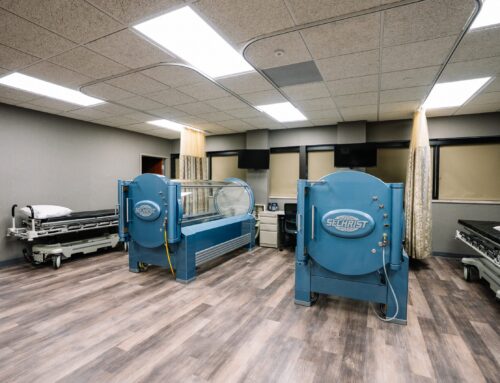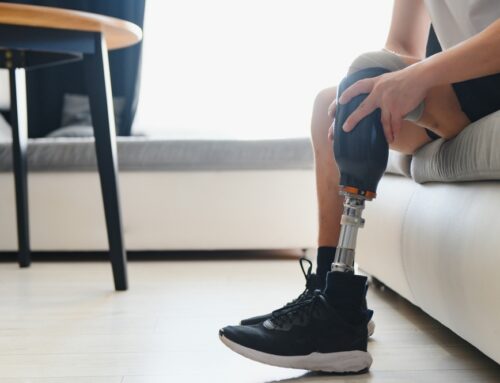Cellular and tissue-based products (CTPs) are designed to speed up wound healing by supporting new tissue growth. Understanding these products can be complex, but our goal is to break it down with this guide to provide more insight into cellular and tissue based products for wound healing. Not only will we unpack how CTPs work, but how they are effective for different wounds, their benefits, and practical applications.
Understanding Cellular and Tissue-Based Products (CTPs)
Cellular and Tissue-Based Products (CTPs) are designed to mimic human skin both in structure and function. Derived from human donors or animal sources, these products are created to closely resemble the extracellular matrix (ECM), providing a scaffold for tissue regeneration and repair.
Unlike traditional treatments like autologous skin grafts, which is done by removing one healthy part of skin to a targeted area, CTPs offer a more versatile and effective solution for wound healing.
The development of CTPs has revolutionized the field of wound care, providing new options for patients with diverse wound types. These products integrate active cellular components and distinctly incorporated tissue, which continue to promote healing long after application.
The use of CTPs in wound management has grown significantly, reflecting their proven efficacy and the ongoing advancements in tissue engineering.
Different Types of CTPs
CTPs come in various forms, each tailored to specific wound healing needs. The primary types include:
- Allografts: Such as Apligraf and TheraSkin, which are derived from human skin making them more compatible and effective.
- Xenografts: Sourced from animals, xenografts provide an alternative when human tissues are not available.
- Human Skin Allograft: Either from a healthy or deceased donor where skin is used as a temporary covering for wounds, mainly burn victims.
- Composite Allograft: Involves the use of skin, bone, muscles, and blood vessels as transplantation typically for a hand or face transplant.
- Acellular Dermal Matrix: The main focus of an acellular dermal matrix is to retain collagen and elastin through a matrix of human and animal skin
Bioengineered skin substitutes are another option which also mimic the properties of natural skin. Some common bioengineered products like Strattice and AlloDerm, incorporate materials such as collagen and elastin to facilitate wound healing. These products are often designed to imitate the structure and function of native tissues, providing a supportive environment for cellular growth and repair.
Benefits of CTPs
Traditional wound treatments, such as autologous skin grafts, have several limitations. Some of these limitations include need for invasive procedures, the risk of scarring, and limited availability. CTPs address these issues by offering a less invasive, more effective alternative. They reduce the need for surgical grafting and provide a readily available solution for various wound types.
The benefits of CTPs extend beyond their ease of use. Benefits of CTPs include:
- Enhance wound healing with a scaffold to support new tissue formation
- Reduce healing time
- Improved over outcomes
CTPs are also particularly beneficial in managing chronic wounds, acute wounds and burns, and surgical wounds.
What Wounds CTPs Can Treat
CTPs have a wide range of applications in wound healing, making them a versatile option for various clinical scenarios. By promoting faster and more effective healing, CTPs can significantly improve patient outcomes and reduce the need for more invasive treatments.
Chronic Wounds
Chronic wounds, such as diabetic foot ulcers, venous leg ulcers, and pressure ulcers, pose a significant challenge in wound management. CTPs play a crucial role in treating these persistent wounds, offering a more effective solution compared to conventional methods. Products like Dermagraft are specifically indicated for diabetic foot ulcers, demonstrating the tailored applications of CTPs.
They help to reduce the complexity and frequency of dressing changes, enhancing patient care and facilitating faster wound closure. CTPs are recommended for clean, non-ischemic wounds that have not healed after four weeks of standard care, providing a valuable tool in the treatment of chronic non-healing wounds.
Acute Wounds and Burns
Acute wounds and burns require prompt and effective treatment to prevent complications and promote healing. CTPs are utilized in the treatment of acute burns due to their ability to promote tissue regeneration. These products provide a protective covering for wounds, supporting the healing process and reducing patient discomfort.
The regenerative capabilities of CTPs make them an ideal choice for treating acute wounds. By mimicking human skin and facilitating the growth of new tissue, CTPs help accelerate the healing process and improve overall outcomes. Their use in burn care highlights their versatility and effectiveness in managing various wound types.
Surgical Wounds
Surgical wounds, including those from skin replacement surgeries, benefit greatly from the use of CTPs. Acellular dermal matrices, for example, provide structural support and improve aesthetic outcomes in procedures like breast reconstruction. These products allow for more accurate placement of the inframammary fold (IMF) and enhance the overall healing process.
The use of CTPs in surgical wound management promotes better healing while preserving the functional and aesthetic aspects of the skin. By providing a scaffold for new tissue growth, CTPs enhance wound stability and facilitate faster recovery. Their integration into surgical procedures reflects their importance in modern wound care.
How CTPs Promote Wound Healing
The effectiveness of CTPs in wound healing lies in their ability to mimic the extracellular matrix and stimulate the body’s natural healing processes. These products provide a scaffold for new tissue formation, reducing healing time and enhancing overall outcomes. Recent developments in CTPs have focused on improving their efficacy and safety, making them a valuable tool in wound care.
CTPs promote healing by stimulating cellular interactions and the release of growth factors, creating a favorable microenvironment for tissue recovery. Their ability to accelerate wound healing and provide structural support makes them an essential component of modern wound management.
Cellular Activity
The cellular components within CTPs play a vital role in facilitating tissue regeneration and repair. These products provide a protective covering for wounds, easing patient discomfort and supporting the healing process. By incorporating active cellular components, CTPs continue to promote healing long after application.
CTPs enhance cellular activity by providing a scaffold that supports the growth and migration of cells necessary for tissue regeneration. This cellular activity is crucial for the healing process, helping to restore the structure and function of damaged tissues.
Growth Factors and Bioactive Compounds
Growth factors and bioactive compounds are essential components of CTPs, playing a critical role in the wound healing process. Growth factors are crucial for processes such as fibroblast activity and angiogenesis during healing. These factors promote cell migration and tissue formation, accelerating the healing process.
CTPs facilitate tissue regeneration by emulating the extracellular matrix (ECM) and integrating growth factors that promote faster healing. The release of bioactive compounds from these products helps create a favorable environment for tissue recovery, enhancing the overall effectiveness of the treatment.
Structural Support
CTPs provide essential structural support to newly formed tissues, promoting stability during the healing stages. Acting as scaffolds, these products support new tissue growth and enhance overall wound stability. This soft tissue support is crucial for maintaining the integrity of the healing tissue and preventing complications.
Bioengineered skin grafts represent a significant advancement in CTP technology, providing scaffolding that supports cellular regeneration and mimics the natural skin structure. By facilitating the migration and proliferation of cells necessary for tissue regeneration, CTPs create an optimal environment for wound healing.
Selecting the Right CTP for Your Needs
Choosing the right CTP requires a thorough assessment of the wound’s characteristics and the patient’s overall health condition. The cost-effectiveness and low disease transmission risk of the CTP are key factors to consider when selecting a product.
Integrating CTPs into wound treatment requires a systematic approach to optimize healing outcomes. By carefully assessing the wound etiology, product compatibility, and cost and availability, clinicians can select the most appropriate CTP for effective wound management.
Assessing Wound Etiology
Understanding the root cause of a wound is crucial for effective management and selecting the appropriate CTP. Proper determination of the wound etiology is the first task in managing wounds, as it helps identify the specific characteristics and needs of the wound. This understanding is critical for choosing the right cellular or tissue-based product and developing an effective treatment strategy.
Product Compatibility
When selecting a CTP, a provider will consider the patient’s condition and how it aligns with the specific features of the product. Matching the selected CTP with the patient’s specific condition is crucial for optimal healing. This compatibility significantly influences the success of the treatment, as the product must be suited to the wound’s particular needs and the patient’s overall health.
Overall compatibility between the CTP and the patient’s condition can enhance the wound healing process, reduce complications, and improve outcomes. By carefully evaluating the patient’s health and the wound’s characteristics, clinicians can make informed decisions that optimize the effectiveness of the CTP treatment.
Cost and Availability
Cost-effectiveness and product availability are key factors in the decision-making process for CTP selection. The financial implications and accessibility of various CTP options play a significant role in the choice of treatment. By considering these factors, clinicians can ensure that the selected CTP is both affordable and readily available, enhancing patient care and optimizing treatment outcomes.
Incorporating both cost-effectiveness and availability in decision-making ultimately benefits the patient by providing a practical and effective treatment option. This approach helps balance the quality of care with financial constraints, ensuring that patients receive the best possible treatment within their means.
Potential Risks with Cellular and Tissue Based Products
While CTPs offer numerous benefits, there are also risks and considerations to keep in mind. Graft rejection and disease transfer are the primary risks linked to allografts and xenografts in wound healing. These factors can significantly affect the success of the healing process. CTPs should not be used in patients with known allergies to their components or in wounds that are actively infected.
Tracking the lot number of the CTP applied is important for quality control and in case of recalls or adverse reactions. Additionally, the trend in CTP pricing is showing significant increases, with newer products commanding higher average sales prices despite limited supporting clinical data. These factors must be considered when selecting and using CTPs in clinical practice.
Rejection and Infection
Allografts generally have better acceptance rates than xenografts, which can lead to graft rejection. Acellular dermal matrices are associated with a risk of infection and complications like mastectomy skin flap necrosis. Complications linked with acellular dermal matrix reconstructions include a higher likelihood of infection and reconstructive failure.
Graft rejection can occur in patients receiving CTPs, impacting the effectiveness of the treatment. Therefore, it is crucial to monitor patients closely for signs of rejection and infection, ensuring prompt intervention if complications arise. This vigilance helps maximize the benefits of CTPs while minimizing potential risks.
Preparing for a CTPs
Proper application of CTPs requires the right preparation to ensure optimal wound conditions. This involves cleaning the wound bed, managing moisture levels, and assessing the wound’s condition, including hemostasis and the presence of any bony structures.
CTPs can be applied directly to the wound without the need for sutures in many cases, simplifying the treatment process. Following these practical steps can enhance the effectiveness of CTPs and promote better healing outcomes.
Preparation and Application
Careful assessment of the wound’s condition is necessary before CTP application. This includes ensuring hemostasis and checking for any bony structures that may affect the treatment. Before applying a CTP, the wound bed must be thoroughly cleaned to enhance the product’s effectiveness. Proper management of the wound environment, including controlling moisture levels, aids in CTP integration.
CTPs can be applied directly to the wound, often without the need for sutures. This simplifies the treatment process and reduces patient discomfort. By following these steps, clinicians can ensure optimal conditions for CTP application, promoting better healing outcomes.
Monitoring and Follow-Up
Regular follow-up appointments are crucial to evaluate the effectiveness of the CTP and adjust treatment as necessary. Typically, follow-ups should occur within a week of application to monitor the wound’s progress. Signs of infection or worsening conditions should be closely monitored during these assessments.
Regular assessments of the wound’s healing progress help determine the effectiveness of the CTP application. Monitoring for signs of infection and ensuring proper documentation of the healing process are crucial for successful wound management. This approach ensures that any issues are promptly addressed, optimizing the treatment outcomes.
Summary
In summary, Cellular and Tissue-Based Products (CTPs) represent a significant advancement in wound care, offering effective solutions for a variety of wound types. From chronic wounds to surgical wounds, CTPs provide a versatile and effective option for promoting healing and improving patient outcomes. The integration of active cellular components and structurally supportive materials makes these products a valuable tool in modern wound management.
As CTP technology continues to evolve, the future of wound care looks promising. By staying informed about the latest advancements and selecting the right products for each patient’s needs, clinicians can optimize treatment outcomes and provide the best possible care. The ongoing research and development in this field will undoubtedly lead to even more effective and innovative solutions for wound healing.
Key Takeaways
- Cellular and Tissue-Based Products (CTPs) mimic human skin and support tissue regeneration, reducing the invasiveness of traditional wound treatments.
- CTPs are effective for managing various wound types, including chronic, acute, and surgical wounds, and significantly improve healing outcomes.
- The selection of appropriate CTPs should consider wound characteristics, patient health, cost-effectiveness, and available clinical evidence to optimize treatment results.
Wound Healing with Innovative Wound Care Specialists in Flint, Michigan
If you’re in need of wound healing and not sure which treatment path to take, then visit us at Innovative Wound Care Specialists in Flint, Michigan. With skilled and knowledgeable providers, we can offer the right treatment care for you and any current wound conditions. Our providers can answer any questions or concerns you may have about your condition, while also providing hope for healing and comfort. Contact us today to learn more, and to schedule your next appointment!





